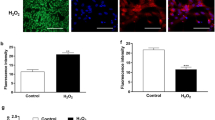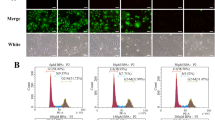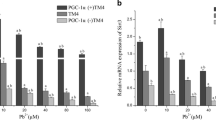Abstract
Lead (Pb), one of the pervasive and protracted environmental heavy metals, is believed to affect the female reproductive system in many species. The Nrf2 and NF-κB are the two key transcriptional factors regulating cellular redox status and response against stress and inflammation respectively, showing an interaction between each other. The aim of this study is to investigate the effect of Pb on bovine granulosa cells (GCs) and its association with the regulation of Nrf2 and NF-κB pathways. For this, bovine GCs were cultured in vitro and exposed to different doses of Pb for 2 h. Cellular response to Pb insult was investigated 24 h post treatment. Results showed that exposure of GCs to Pb-induced ROS accumulation and protein carbonylation. Additionally, GCs exhibited reduction in cell viability and decrease in the expression of cell proliferation marker genes (CCND2 and PCNA). This was accompanied by cell cycle arrest at G0/G1 phase. Moreover, Pb downregulated both Nrf2 and NF-κB and their downstream genes. Lead increased the expression of endoplasmic reticulum (ER) stress marker genes (GRP78 and CHOP) and the proapoptotic gene (caspase-3) while the antiapoptotic gene (BCL-2) was reduced. Our findings suggest that Pb-driven oxidative stress affected GCs proliferation, enhances ER stress, induces cell cycle arrest and mediates apoptosis probably via disruption of Nrf2/NF-κB cross-talk. However, further functional analysis is required to explain different aspects of Nrf2 and NF-κB interactions under metal challenge.







Similar content being viewed by others
Abbreviations
- BAX:
-
Bcl-2-associated X protein
- BCL-2:
-
B cell lymphoma 2
- CAT:
-
catalase
- CCND2:
-
cyclin-D2
- CHOP:
-
C/EBP homologous protein
- GRP78:
-
78 kDa glucose-regulated protein
- HO-1:
-
Heme oxygenase-1
- IKK:
-
inhibitor of nuclear factor-kappaB kinase
- Keap-1:
-
kelch-like ECH-associated protein 1
- NF-κB:
-
nuclear factor-kappa-light-chain-enhancer of activated B cells
- Nrf2:
-
nuclear factor (erythroid-derived 2)-like 2
- PCNA:
-
proliferating cell nuclear antigen
- SOD:
-
superoxide dismutase
- TNF-α:
-
tumor necrosis factor alpha
- Thrx:
-
thioredoxin
References
Abdel Moneim AE (2016) Indigofera oblongifolia prevents lead acetate-induced hepatotoxicity, oxidative stress, fibrosis and apoptosis in rats. PLoS One 11(7):e0158965. https://doi.org/10.1371/journal.pone.0158965
Ahamed M, Siddiqui MKJ (2007) Low level lead exposure and oxidative stress: current opinions. Clin Chim Acta 383(1–2):57–64
Alemu TW, Pandey HO, Salilew Wondim D, Gebremedhn S, Neuhof C, Tholen E, Holker M, Schellander K, Tesfaye D (2018) Oxidative and endoplasmic reticulum stress defense mechanisms of bovine granulosa cells exposed to heat stress. Theriogenology 110:130–141. https://doi.org/10.1016/j.theriogenology.2017.12.042
Ashafaq M, Tabassum H, Vishnoi S, Salman M, Raisuddin S, Parvez S (2016) Tannic acid alleviates lead acetate-induced neurochemical perturbations in rat brain. Neurosci Lett 617:94–100. https://doi.org/10.1016/j.neulet.2016.02.001
Bayat F, Akbari SAA, Dabirioskoei A, Nasiri M, Mellati A (2016) The relationship between blood lead level and preeclampsia. Electron Physician 8:3450–3455. https://doi.org/10.19082/3450
Bellezza I, Mierla AL, Minelli A (2010) Nrf2 and NF-κB and their concerted modulation in cancer pathogenesis and progression. Cancers 2:483–497. https://doi.org/10.3390/cancers2020483
Bires J, Maracek I, Bartko P, Biresova M, Weissova T (1995) Accumulation of trace elements in sheep and the effects upon qualitative and quantitative ovarian changes. Vet Hum Toxicol 37:349–356
Bolisetty S, Jaimes EA (2013) Mitochondria and reactive oxygen species: physiology and pathophysiology. Int J Mol Sci 214:6306–6344. https://doi.org/10.3390/ijms14036306
Chen F, Shi X (2002) Signaling from toxic metals to NF-kappaB and beyond: not just a matter of reactive oxygen species. Environ Health Perspect 110:807–811
Chowdhury AR (2009) Recent advances in heavy metals induced effect on male reproductive function-a retrospective. Al Ameen J Med Sci 2:37–42
Darzynkiewicz Z, Zhao H, Halicka HD, Rybak P, Dobrucki J, Wlodkowic D (2012) DNA damage signaling assessed in individual cells in relation to the cell cycle phase and induction of apoptosis. Crit Rev Clin Lab Sci 49:199–217. https://doi.org/10.3109/10408363.2012.738808
Dieguez-Acuna FJ, Polk WW, Ellis ME, Simmonds PL, Kushleika JV, Woods JS (2004) Nuclear factor kappaB activity determines the sensitivity of kidney epithelial cells to apoptosis. Implications for mercury-induced renal failure. Toxicol Sci 82:114–123. https://doi.org/10.1093/toxsci/kfh236
Doumouchtsis KK, Doumouchtsis SK, Doumouchtsis EK, Perrea DN (2009) The effect of lead intoxication on endocrine functions. J Endocrinol Investig 32:175–183. https://doi.org/10.1007/BF03345710
Eum K-D, Weisskopf MG, Nie LH, Hu H, Korrick SA (2014) Cumulative lead exposure and age at menopause in the Nurses’ Health Study cohort. Environ Health Perspect 122:229–234. https://doi.org/10.1289/ehp.1206399
Flora G, Gupta D, Tiwari A (2012) Toxicity of lead: a review with recent updates. Interdiscip Toxicol 5:47–58. https://doi.org/10.2478/v10102-012-0009-2
Gebremedhn S, Salilew-Wondim D, Ahmad I, Sahadevan S, Hossain MM, Hoelker M, Rings F, Neuhoff C, Tholen E, Looft C, Schellander K, Tesfaye D, Zhang M (2015) MicroRNA expression profile in bovine granulosa cells of preovulatory dominant and subordinate follicles during the late follicular phase of the estrous cycle. PLoS One 10:e0125912. https://doi.org/10.1371/journal.pone.0125912
Hasanein P, Ghafari-Vahed M, Khodadadi I (2017) Effects of isoquinoline alkaloid berberine on lipid peroxidation, antioxidant defense system, and liver damage induced by lead acetate in rats. Redox Rep 22:42–50. https://doi.org/10.1080/13510002.2016.1140406
Jahromi BN, Mosallanezhad Z, Matloob N, Davari M, Ghobadifar MA (2015) The potential role of granulosa cells in the maturation rate of immature human oocytes and embryo development: a co-culture study. Clin Exp Reprod Med 42:111–117. https://doi.org/10.5653/cerm.2015.42.3.111
Lee AS (2014) Glucose regulated proteins in cancer. Molecular mechanisms and therapeutic potential. Nat Rev Cancer 14:263–276. https://doi.org/10.1038/nrc3701
Levine RL, Wehr N, Williams JA, Stadtman ER, Shacter E (2000) Determination of carbonyl groups in oxidized proteins. Methods Mol Biol 99:15–24. https://doi.org/10.1385/1-59259-054-3:15
Lim J, Ortiz L, Nakamura BN, Hoang YD, Banuelos J, Flores VN, Chan JY, Luderer U (2015) Effects of deletion of the transcription factor Nrf2 and benzo[a]pyrene treatment on ovarian follicles and ovarian surface epithelial cells in mice. Reprod Toxicol 58:24–32. https://doi.org/10.1016/j.reprotox.2015.07.080
Lin P, Yang Y, Li X, Chen F, Cui C, Hu L, Li Q, Liu W, Jin Y (2012) Endoplasmic reticulum stress is involved in granulosa cell apoptosis during follicular atresia in goat ovaries. Mol Reprod Dev 79:423–432. https://doi.org/10.1002/mrd.22045
Liu C-M, Zheng GH, Ming QL, Sun JM, Cheng C (2013) Protective effect of quercetin on lead-induced oxidative stress and endoplasmic reticulum stress in rat liver via the IRE1/JNK and PI3K/Akt pathway. Free Radic Res 47:192–201. https://doi.org/10.3109/10715762.2012.760198
Liu CM, Ma JQ, Xie WR, Liu SS, Feng ZJ, Zheng GH, Wang AM (2015) Quercetin protects mouse liver against nickel-induced DNA methylation and inflammation associated with the Nrf2/HO-1 and p38/STAT1/NF-κB pathway. Food Chem Toxicol 82:19–26. https://doi.org/10.1016/j.fct.2015.05.001
Liu B, Zhang H, Tan X, Yang D, Lv Z, Jiang H, Lu J, Baiyun R, Zhang Z (2017) GSPE reduces lead-induced oxidative stress by activating the Nrf2 pathway and suppressing miR153 and GSK-3beta in rat kidney. Oncotarget 8:42226–42237. https://doi.org/10.18632/oncotarget.15033
Livak KJ, Schmittgen TD (2001) Analysis of relative gene expression data using real-time quantitative PCR and the 2−ΔΔCt method. Methods 25:402–408. https://doi.org/10.1006/meth.2001.1262
Lu J, Wang Z, Cao J, Chen Y, Dong Y (2018) A novel and compact review on the role of oxidative stress in female reproduction. Reprod Biol Endocrinol 16:80. https://doi.org/10.1186/s12958-018-0391-5
Luderer U (2014) Ovarian toxicity from reactive oxygen species. Vitam Horm 94:99–127. https://doi.org/10.1016/B978-0-12-800095-3.00004-3
Luo S, Mao C, Lee B, Lee AS (2006) GRP78/BiP is required for cell proliferation and protecting the inner cell mass from apoptosis during early mouse embryonic development. Mol Cell Biol 26:5688–5697. https://doi.org/10.1128/MCB.00779-06
Meakin PJ, Chowdhry S, Sharma RS, Ashford FB, Walsh SV, McCrimmon RJ, Dinkova-Kostova AT, Dillon JF, Hayes JD, Ashford MLJ (2014) Susceptibility of Nrf2-null mice to steatohepatitis and cirrhosis upon consumption of a high-fat diet is associated with oxidative stress, perturbation of the unfolded protein response, and disturbance in the expression of metabolic enzymes but not with insulin resistance. Mol Cell Biol 34:3305–3320. https://doi.org/10.1128/MCB.00677-14
Meng Q-T, Chen R, Chen C, Su K, Li W, Tang L-H, Liu H-M, Xue R, Sun Q, Leng Y, Hou J-B, Wu Y, Xia Z-Y (2017) Transcription factors Nrf2 and NF-κB contribute to inflammation and apoptosis induced by intestinal ischemia-reperfusion in mice. Int J Mol Med 40:1731–1740. https://doi.org/10.3892/ijmm.2017.3170
Nakajima S, Kitamura M (2013) Bidirectional regulation of NF-kappaB by reactive oxygen species: a role of unfolded protein response. Free Radic Biol Med 65:162–174. https://doi.org/10.1016/j.freeradbiomed.2013.06.020
Nandi S, Gupta PS, Selvaraju S, Roy SC, Ravindra JP (2010) Effects of exposure to heavy metals on viability, maturation, fertilization, and embryonic development of buffalo (Bubalus bubalis) oocytes in vitro. Arch Environ Contam Toxicol 58:194–204. https://doi.org/10.1007/s00244-009-9342-7
Paksy K, Gati I, Naray M, Rajczy K (2001) Lead accumulation in human ovarian follicular fluid, and in vitro effect of lead on progesterone production by cultured human ovarian granulosa cells. J Toxicol Environ Health A 62:359–366. https://doi.org/10.1080/152873901300018093
Pan H, Wang H, Wang X, Zhu L, Mao L (2012) The absence of Nrf2 enhances NF-kappaB-dependent inflammation following scratch injury in mouse primary cultured astrocytes. Mediat Inflamm 2012:217580. https://doi.org/10.1155/2012/217580
Perkins ND, Gilmore TD (2006) Good cop, bad cop: the different faces of NF-kappaB. Cell Death Differ 213:759–772. https://doi.org/10.1038/sj.cdd.4401838
Qureshi N, Sharma R, Mogra S, Panwar K (2010) Protective effects of combined treatment of vitamin E and C on lead induced folliculogenesis in swiss mice. J Herbal Med Toxic 4:207–213
Sahin K, Pala R, Tuzcu M, Ozdemir O, Orhan C, Sahin N, Juturu V (2016) Curcumin prevents muscle damage by regulating NF-kappaB and Nrf2 pathways and improves performance. an in vivo model. J Inflamm Res 9:147–154. https://doi.org/10.2147/JIR.S110873
Sanders T, Liu Y, Buchner V, Tchounwou PB (2009) Neurotoxic effects and biomarkers of lead exposure: a review. Rev Environ Health 24:15–45
Santos RR, Schoevers EJ, Roelen BAJ (2014) Usefulness of bovine and porcine IVM/IVF models for reproductive toxicology. Reprod Biol Endocrinol 12:117. https://doi.org/10.1186/1477-7827-12-117
Seyom E, Abera M, Tesfaye M, Fentahun N (2015) Maternal and fetal outcome of pregnancy related hypertension in Mettu Karl Referral Hospital, Ethiopia. J Ovarian Res 8:10. https://doi.org/10.1186/s13048-015-0135-5
Shan G, Tang T, Zhang X (2009) The protective effect of ascorbic acid and thiamine supplementation against damage caused by lead in the testes of mice. J Huazhong Univ Sci Technolog Med Sci 29:68–72. https://doi.org/10.1007/s11596-009-0114-4
Sharma R, Qureshi N, Mogra S, Panwar K (2012) Lead induced infertility in Swiss mice and role of antioxidants. Univers J Environ Res Technol 2:75–82
Swarup D, Patra RC, Naresh R, Kumar P, Shekhar P (2005) Blood lead levels in lactating cows reared around polluted localities; transfer of lead into milk. Sci Total Environ 347:106–110. https://doi.org/10.1016/j.scitotenv.2004.12.055
Taupeau C, Poupon J, Nome F, Lefevre B (2001) Lead accumulation in the mouse ovary after treatment-induced follicular atresia. Reprod Toxicol 15:385–391
Taylor CM, Golding J, Hibbeln J, Emond AM (2013) Environmental factors predicting blood lead levels in pregnant women in the UK. PLoS One 8:e72371–e72371. https://doi.org/10.1371/journal.pone.0072371
van Engeland M, Ramaekers FC, Schutte B, Reutelingsperger CP (1996) A novel assay to measure loss of plasma membrane asymmetry during apoptosis of adherent cells in culture. Cytometry 24:131–139. https://doi.org/10.1002/(SICI)1097-0320(19960601)24:2<131:AID-CYTO5>3.0.CO;2-M
Vigeh M, Yokoyama K, Seyedaghamiri Z, Shinohara A, Matsukawa T, Chiba M, Yunesian M (2011) Blood lead at currently acceptable levels may cause preterm labour. Occup Environ Med 68:231–234. https://doi.org/10.1136/oem.2009.050419
Wakabayashi N, Slocum SL, Skoko JJ, Shin S, Kensler TW (2010) When NRF2 talks, who’s listening? Antioxid Redox Signal 13:1649–1663. https://doi.org/10.1089/ars.2010.3216
Wang Y, Chan S, Tsang BK (2002) Involvement of inhibitory nuclear factor-kappaB (NFkappaB)-independent NFkappaB activation in the gonadotropic regulation of X-linked inhibitor of apoptosis expression during ovarian follicular development in vitro. Endocrinology 143:2732–2740. https://doi.org/10.1210/endo.143.7.8902
Wardyn JD, Ponsford AH, Sanderson CM (2015) Dissecting molecular cross-talk between Nrf2 and NF-κB response pathways. Biochem Soc Trans 43:621–626. https://doi.org/10.1042/BST20150014
Xie J, Shaikh ZA (2006) Cadmium-induced apoptosis in rat kidney epithelial cells involves decrease in nuclear factor-kappa B activity. Toxicol Sci 91:299–308. https://doi.org/10.1093/toxsci/kfj131
Yedjou CG, Tchounwou HM, Tchounwou PB (2015) DNA damage, cell cycle arrest, and apoptosis induction caused by lead in human leukemia cells. Int J Environ Res Public Health 13:ijerph13010056. https://doi.org/10.3390/ijerph13010056
Zhang Y, Sun L-G, Ye L-P, Wang B, Li Y (2008) Lead-induced stress response in endoplasmic reticulum of astrocytes in CNS. Toxicol Mech Methods 18:751–757. https://doi.org/10.1080/15376510802390908
Zhang M, An C, Gao Y, Leak RK, Chen J, Zhang F (2013) Emerging roles of Nrf2 and phase II antioxidant enzymes in neuroprotection. Prog Neurobiol 100:30–47. https://doi.org/10.1016/j.pneurobio.2012.09.003
Acknowledgments
We are grateful to members of the Flow Cytometry Core Facility at the Institute of Molecular Medicine, University of Bonn and to the Confocal Microscope Facility in Institut für Nutzpflanzenwissenschaften und Ressourcenschutz (INRES), University of Bonn.
Author information
Authors and Affiliations
Corresponding author
Ethics declarations
Competing interests
The authors declare that they have no conflict of interest.
Ethical approval
This article does not contain any studies with animals performed by any of the authors.
Ethical statement
All authors declare that this research was done by strictly adhering to the rules of good scientific practice and are responsible for its content. All experiments were performed in a manner that maximized rigor and reproducibility and without bias.
Additional information
Publisher’s note
Springer Nature remains neutral with regard to jurisdictional claims in published maps and institutional affiliations.
Rights and permissions
About this article
Cite this article
Aglan, H.S., Gebremedhn, S., Salilew-Wondim, D. et al. Regulation of Nrf2 and NF-κB during lead toxicity in bovine granulosa cells. Cell Tissue Res 380, 643–655 (2020). https://doi.org/10.1007/s00441-020-03177-x
Received:
Accepted:
Published:
Issue Date:
DOI: https://doi.org/10.1007/s00441-020-03177-x




